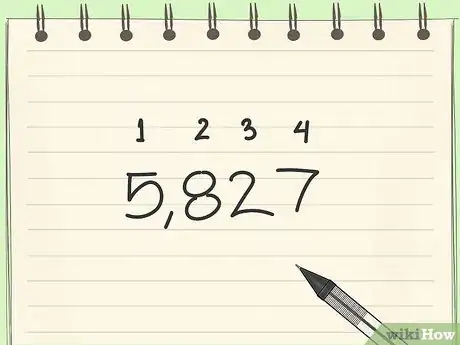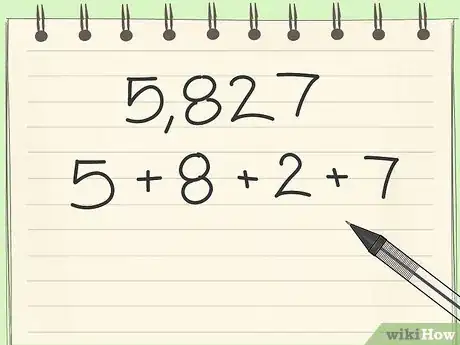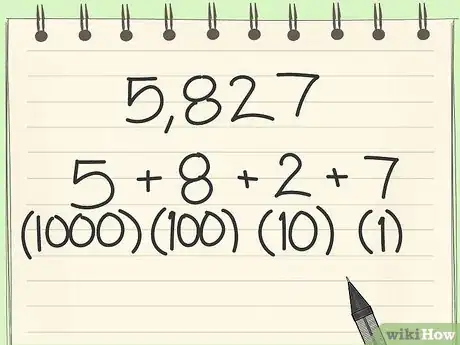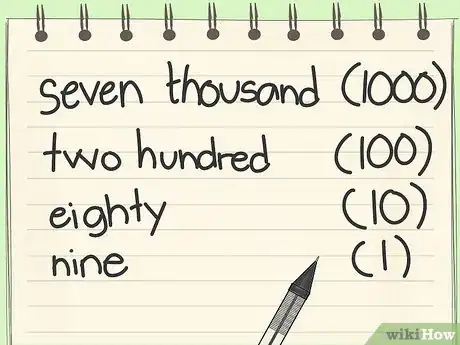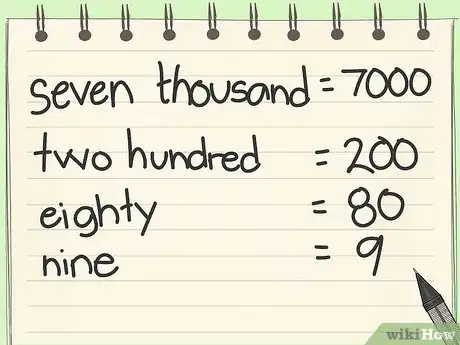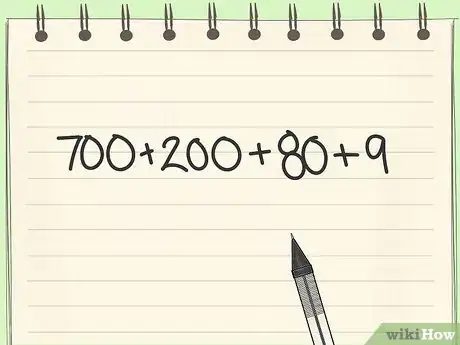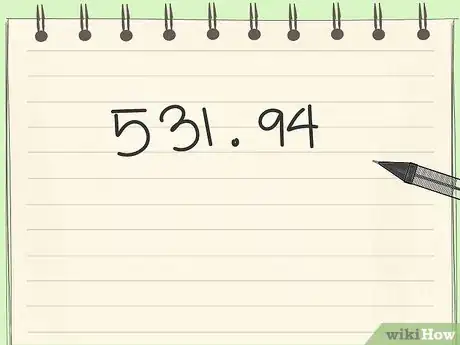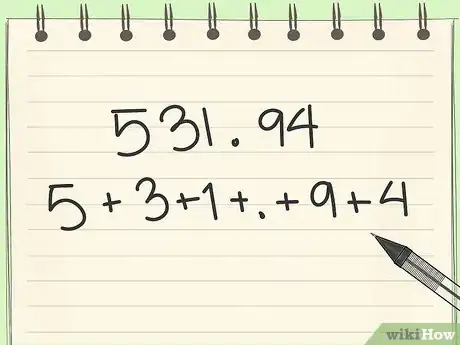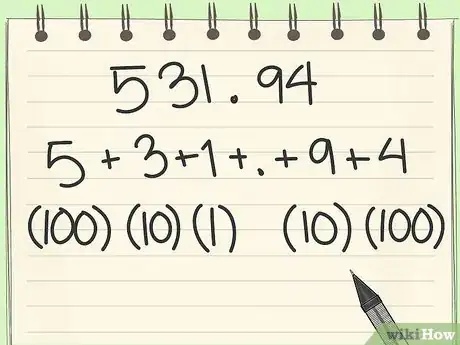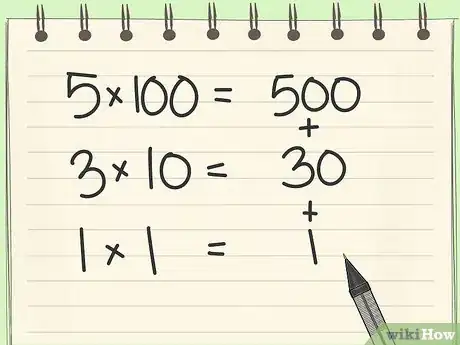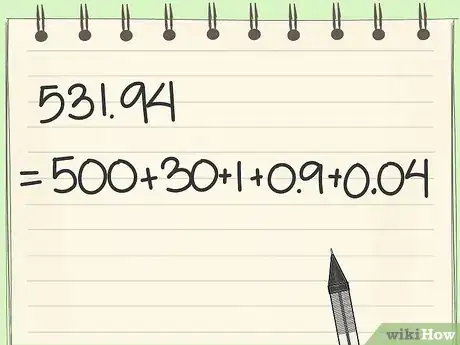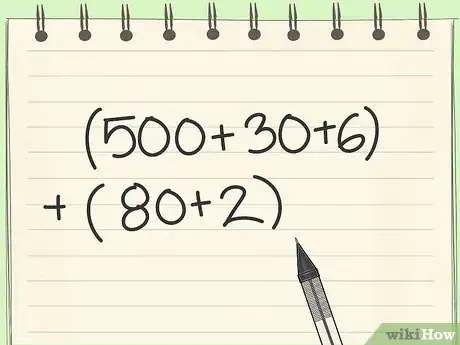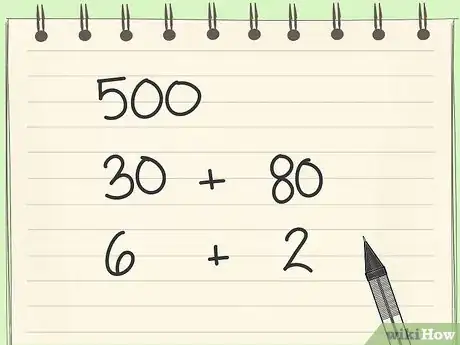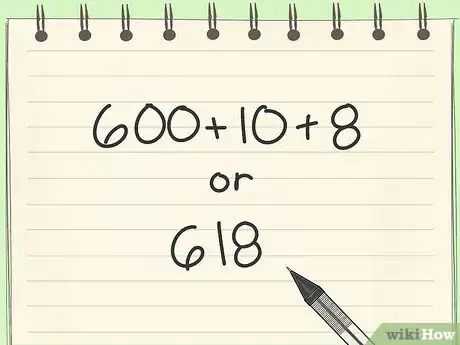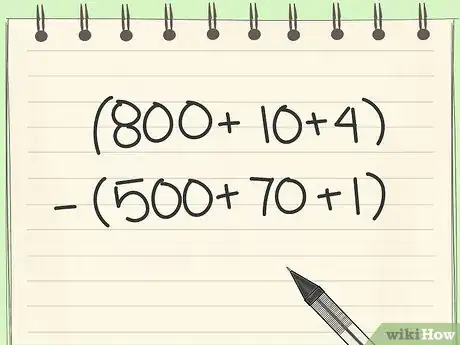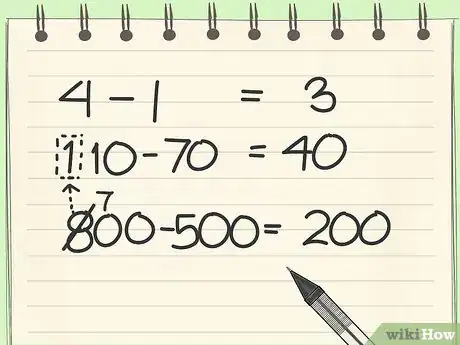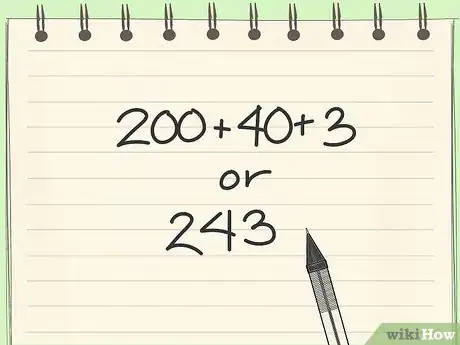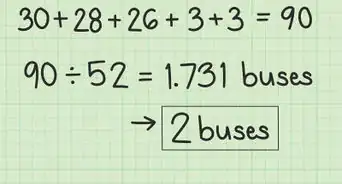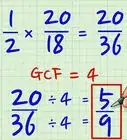X
wikiHow is a “wiki,” similar to Wikipedia, which means that many of our articles are co-written by multiple authors. To create this article, volunteer authors worked to edit and improve it over time.
There are 7 references cited in this article, which can be found at the bottom of the page.
This article has been viewed 75,292 times.
Learn more...
Expanded form is a way to rewrite a numerical value that breaks up that value into separate digits, showing how much each digit actually represents in the process. Writing expanded form is fairly simple once you understand what it is.
Steps
Part 1
Part 1 of 5:
Part One: Change Standard Form to Expanded Form
-
1Look at the number in standard form. Read the number and look at how many digits are in it.[1]
-
Example: Write 5,827 in expanded form.
- Read the number silently or out loud: five thousand, eight hundred twenty seven.
- Notice that there are four separate digits in this number. As a result, there will be four separate places in the expanded form of this number.
-
Example: Write 5,827 in expanded form.
-
2Separate the digits. Rewrite the number so that each of its digits are separated by a plus sign. Leave a little room in between each digit and the plus sign that follows it. More information will need to be included there.
-
Example: The number 5,827 temporarily becomes:
- 5 + 8 + 2 + 7
Advertisement -
Example: The number 5,827 temporarily becomes:
-
3Identify each place value name. Each digit in your original number corresponds to a specific place value. Starting from the lowest digit, label each digit with its appropriate place value name.[2]
-
Example: Since there are four digits in this number, you will need to count up four place values.
- The smallest digit is 7, and that corresponds to the ones (1) place.
- The next digit is 2, which corresponds to the tens (10) place.
- The third digit is 8, which sits in the hundreds (100) place.
- The fourth and final digit is 5, and it sits in the thousands (1000) place.
-
Example: Since there are four digits in this number, you will need to count up four place values.
-
4Multiply each digit by its appropriate place value. Multiply each separate digit in your original number by the place value that matches where it belongs within the full, original number.[3]
- Example: [5 * 1000] + [8 * 100] + [2 * 10] + [7 * 1]
-
5Write your final answer. Once the digits have been multiplied together, you should have the final expanded form of the original number.[4]
-
Example: The expanded form of 5,827 is:
- 5000 + 800 + 20 + 7
-
Example: The expanded form of 5,827 is:
Advertisement
Part 2
Part 2 of 5:
Part Two: Change Written Form to Expanded Form
-
1Look at the number in written form. Read the number as it is written. When a number is in this form, you should be able to identify the full value of each separate digit.[5]
- Example: Write the following in expanded form: seven thousand two hundred eighty nine.
-
2Identify each place value name. Write each digit separately, attaching the appropriate place value name after it. The correct place value will simply be the one that is already written beside the value. Include plus signs in between each written value.[6]
- Note that the “tens” and “ones” place values are not specifically labeled, but they should be understood. You can indicate your understanding by marking the place value name in parentheses, but doing so is not strictly necessary.
-
Example: The number seven thousand two hundred eighty nine becomes:
- seven thousand + two hundred + eighty (tens) + nine (ones)
- OR
- seven thousand + two hundred + eighty + nine
-
3Rewrite the written place value as a numeric place value. Look at each separate value. Rewrite each value as it reads to the equal numeric value.
-
Example: Seven thousand + two hundred + eighty + nine:
- Seven thousand = 7000
- Two hundred = 200
- Eighty = 80
- Nine = 9
-
Example: Seven thousand + two hundred + eighty + nine:
-
4Write the final answer. You should have all the information you need now to write the original written form number in expanded form.
-
Example: The expanded form of seven thousand two hundred eighty nine is:
- 7000 + 200 + 80 + 9
-
Example: The expanded form of seven thousand two hundred eighty nine is:
Advertisement
Part 3
Part 3 of 5:
Part Three: Expanded Form with Decimals
-
1Look at the number in standard form. Read the number and count how many digits are in it, paying special attention to the digits that come after (to the right of) the decimal point.[7]
- Example: Write 531.94 in expanded form.
- Read the number: five hundred thirty one and 94 hundredths.
- Notice that there are three digits before the decimal point and two digits after the decimal point. There will be a total of five separate places in the expanded form of this number.
-
2Separate the digits. Rewrite the number, separating each individual digit by a plus sign. For now, write the decimal point, too.[8]
- Note that the decimal point will eventually be removed, but you should keep it in place for now to prevent confusion while solving the problem.
- Leave some space in between the digits and the plus signs. More information will need to be written there.
-
Example: The number 531.94 temporarily becomes:
- 5 + 3 + 1 + . + 9 + 4
-
3Identify each place value name. Label each digit with the place value name that matches its position in the original number.[9]
- When working before (to the left of) the decimal point, work from the lowest number to the highest.
- When working after (to the right of) the decimal point, work from the highest number to the lowest.
-
Example: You will need to count three places to the left and two places to the right.
- For the left values:
- The smallest number is 1, which matches the ones (1) place.
- The second number is 3, which matches the tens (10) place.
- The largest number is 5, which sits in the hundreds (100) place.
- For the right values:
- The largest number is 9, which sits in the tenths (10) place.
- The smallest number is 4, which sits in the hundredths (100) place.
-
4Multiply the left digits by the appropriate value. All of the digits on the left side of the decimal point must be multiplied by their matching place value. Do that now.[10]
- Example: [5 * 100] + [3 * 10] + [1 * 1] = 500 + 30 + 1
-
5Divide the right digits by the appropriate value. All of the digits on the right side of the decimal point must be divided by their matching place value. Do that now.
- Example: [9 / 10] + [4 / 100] = 0.9 + 0.04
-
6Write your final answer. Combine all of your rewritten values together, placing plus signs in between each one. Remove the decimal point. This will be your final answer.[11]
-
Example: The expanded form of 531.94 is:
- 500 + 30 + 1 + 0.9 + 0.04
-
Example: The expanded form of 531.94 is:
Advertisement
Part 4
Part 4 of 5:
Part Four: Add Expanded Form
-
1Look at the problem. Verify that you need to add together the expanded forms of two or more numbers. If the problem is written out in both words and numerals instead of numerals only, pull the numerals out of the problem and set them up in the addition format.[12]
- If you are given numbers in written form or standard form but need to show your work in expanded form, rewrite each number in expanded form before continuing.
-
Example: Add [500 + 30 + 6] and [80 + 2] together.
- Rewrite the problem as: 500 + 30 + 6 + 80 + 2
-
2Separate the numbers by place value. Identify all numbers in the ones place value, followed by all numbers in the tens place value, followed by all the numbers in the hundreds place value. Continue in this manner to identify all currently used place values. Rewrite the problem, arranging the various place values together.[13]
-
Example: For 500 + 30 + 6 + 80 + 2:
- Hundreds place value: 500
- Tens place value: 30 + 80
- Ones place value: 6 + 2
-
Example: For 500 + 30 + 6 + 80 + 2:
-
3Add each place value group separately. Add up all of numbers in each place value category. Start with the ones place value and work your way up to the largest place value.[14]
- Note that if the sum of one place value exceeds the proper amount of digits within that place value category, you must add the extra digit to the place category above it.
-
Example: Start with the ones place value, followed by the tens, followed by the hundreds.
- 6 + 2 = 8
- 30 + 80 = 110; since this value exceeds the tens place category, you separate it into 100 + 10; keep the 10 here and add the 100 to the next place category as follows
- 500 + 100 = 600
-
4Write your final answer. Arrange the sums of each category in a row, separating them with plus signs. This is the expanded form of your answer.
- If you wanted to write the standard form of the answer, all you would need to do is add the digits together.
-
Example: 500 + 30 + 6 + 80 + 2 = 600 + 10 + 8
- In standard form, the answer would be 618.
Advertisement
Part 5
Part 5 of 5:
Part Five: Subtract Expanded Form
-
1Look at the problem. Make sure that you are being told to subtract the expanded forms of two numbers. If the question is phrased as a word problem, pull the numerals out of the problem and arrange them in subtraction format.[15]
- Note that you should rewrite any numbers originally in standard or written form if the question explicitly tells you to show your work in expanded form.
-
Example: Subtract [500 + 70 + 1] from [800 + 10 + 4].
- Rewrite as: [800 + 10 + 4] – [500 + 70 + 1]
- Or: 800 + 10 + 4 – 500 – 70 - 1
-
2Separate the numbers by place value. Identify all numbers falling into separate place value categories (ones, tens, hundreds, thousands, etc.). Rewrite the problem so that all numbers belonging to the same place value category are grouped together.[16]
-
Example: For [800 + 10 + 4] – [500 + 70 + 1]:
- Hundreds: 800 – 500
- Tens: 10 – 70
- Ones: 4 – 1
-
Example: For [800 + 10 + 4] – [500 + 70 + 1]:
-
3Subtract each place value group separately. Subtract the numbers in each place value category. Start with the lowest category (ones) and gradually work your way up to the highest.[17]
- If the number you are subtracting from is smaller than the number you must subtract from it, you will need to take an entire place value from the category above it. For instance, take “10” from the tens category if the values in the ones category cannot be subtracted as they are.
-
Example: Start with the ones category, followed by the tens, followed by the hundreds.
- 4 – 1 = 3
- 10 – 70; since “70” is larger than “10,” you'll need to take “100” from the “800” and add it to the “10,” making this equation: 110 – 70 = 40
- 700 – 500 = 200; the “800” became “700” when you took the “100” for the tens category
-
4Write the final answer. Arrange the differences from each category in a row, separating them with plus signs. This is the expanded form of your final answer.
- To find the standard form of this answer, all you need to do is add the digits of the expanded form together.
-
Example: [800 + 10 + 4] – [500 + 70 + 1] = 200 + 40 + 3
- In standard form, the answer would be: 243
Advertisement
Community Q&A
-
QuestionWhat is the expanded form of 11.005?
 Community AnswerIt would be 10 + 1 + 0.005.
Community AnswerIt would be 10 + 1 + 0.005. -
QuestionWhat’s the expanded form for 888.741?
 DonaganTop Answerer800 + 80 + 8 + .7 + .04 + .001.
DonaganTop Answerer800 + 80 + 8 + .7 + .04 + .001. -
QuestionHow do I write number in expanded form that are in different base?
 DonaganTop AnswererHere's an example. The base-8 number 4,321 is expanded like this: (4 x 512) + (3 x 64) + (2 x 8) + (1 x 1). (In base-10 that's 2048 + 192 + 16 + 1 = 2257.)
DonaganTop AnswererHere's an example. The base-8 number 4,321 is expanded like this: (4 x 512) + (3 x 64) + (2 x 8) + (1 x 1). (In base-10 that's 2048 + 192 + 16 + 1 = 2257.)
Advertisement
References
- ↑ http://www.aaamath.com/g4_31dpx.htm
- ↑ http://www.aaamath.com/g4_31dpx.htm
- ↑ http://mathforum.org/library/drmath/view/57137.html
- ↑ http://mathforum.org/library/drmath/view/57137.html
- ↑ https://www.khanacademy.org/math/pre-algebra/pre-algebra-arith-prop/pre-algebra-place-value/v/place-value-3
- ↑ https://www.khanacademy.org/math/pre-algebra/pre-algebra-arith-prop/pre-algebra-place-value/v/place-value-3
- ↑ https://www.youtube.com/watch?v=GQPAt8v2KEk
- ↑ https://www.youtube.com/watch?v=GQPAt8v2KEk
- ↑ https://mashupmath.com/blog/expanded-form-with-decimals
- ↑ https://www.youtube.com/watch?v=GQPAt8v2KEk
- ↑ https://mashupmath.com/blog/expanded-form-with-decimals
- ↑ https://www.math-only-math.com/adding-numbers-in-expanded-form.html
- ↑ https://www.math-only-math.com/adding-numbers-in-expanded-form.html
- ↑ https://www.math-only-math.com/adding-numbers-in-expanded-form.html
- ↑ https://www.youtube.com/watch?v=FMcOdKk5Sd0
- ↑ https://www.youtube.com/watch?v=FMcOdKk5Sd0
- ↑ https://www.youtube.com/watch?v=FMcOdKk5Sd0
About This Article
Advertisement
